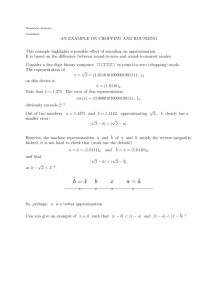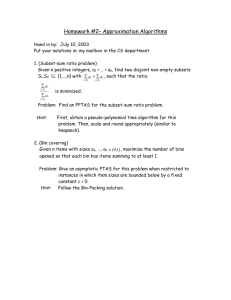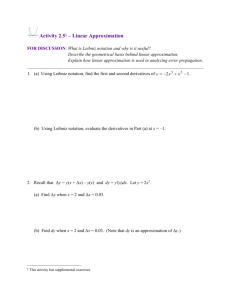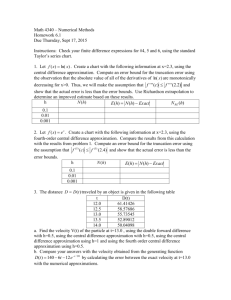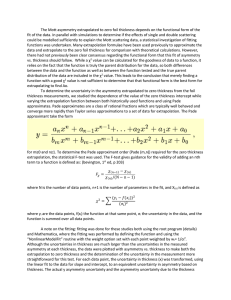Abstract—The frequency-domain exponential transfer
advertisement
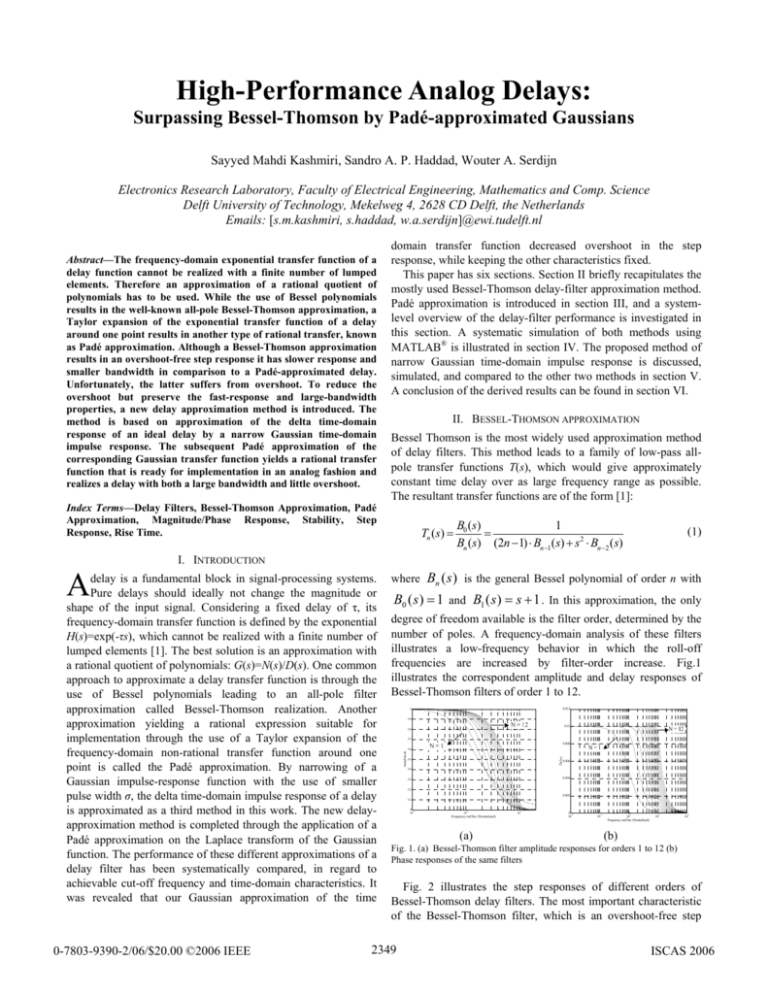
High-Performance Analog Delays: Surpassing Bessel-Thomson by Padé-approximated Gaussians Sayyed Mahdi Kashmiri, Sandro A. P. Haddad, Wouter A. Serdijn Electronics Research Laboratory, Faculty of Electrical Engineering, Mathematics and Comp. Science Delft University of Technology, Mekelweg 4, 2628 CD Delft, the Netherlands Emails: [s.m.kashmiri, s.haddad, w.a.serdijn]@ewi.tudelft.nl Abstract—The frequency-domain exponential transfer function of a delay function cannot be realized with a finite number of lumped elements. Therefore an approximation of a rational quotient of polynomials has to be used. While the use of Bessel polynomials results in the well-known all-pole Bessel-Thomson approximation, a Taylor expansion of the exponential transfer function of a delay around one point results in another type of rational transfer, known as Padé approximation. Although a Bessel-Thomson approximation results in an overshoot-free step response it has slower response and smaller bandwidth in comparison to a Padé-approximated delay. Unfortunately, the latter suffers from overshoot. To reduce the overshoot but preserve the fast-response and large-bandwidth properties, a new delay approximation method is introduced. The method is based on approximation of the delta time-domain response of an ideal delay by a narrow Gaussian time-domain impulse response. The subsequent Padé approximation of the corresponding Gaussian transfer function yields a rational transfer function that is ready for implementation in an analog fashion and realizes a delay with both a large bandwidth and little overshoot. Index Terms—Delay Filters, Bessel-Thomson Approximation, Padé Approximation, Magnitude/Phase Response, Stability, Step Response, Rise Time. II. BESSEL-THOMSON APPROXIMATION Bessel Thomson is the most widely used approximation method of delay filters. This method leads to a family of low-pass allpole transfer functions T(s), which would give approximately constant time delay over as large frequency range as possible. The resultant transfer functions are of the form [1]: Tn (s) = B0 (s) 1 = Bn (s) (2n −1) ⋅ Bn−1(s) + s2 ⋅ Bn−2 (s) (1) I. INTRODUCTION 0-7803-9390-2/06/$20.00 ©2006 IEEE where Bn (s ) is the general Bessel polynomial of order n with B0 ( s ) = 1 and B1 ( s ) = s + 1 . In this approximation, the only degree of freedom available is the filter order, determined by the number of poles. A frequency-domain analysis of these filters illustrates a low-frequency behavior in which the roll-off frequencies are increased by filter-order increase. Fig.1 illustrates the correspondent amplitude and delay responses of Bessel-Thomson filters of order 1 to 12. 0.012 1 0.9 0.01 0.8 0.7 0.008 0.6 D elay delay is a fundamental block in signal-processing systems. Pure delays should ideally not change the magnitude or shape of the input signal. Considering a fixed delay of τ, its frequency-domain transfer function is defined by the exponential H(s)=exp(-τs), which cannot be realized with a finite number of lumped elements [1]. The best solution is an approximation with a rational quotient of polynomials: G(s)=N(s)/D(s). One common approach to approximate a delay transfer function is through the use of Bessel polynomials leading to an all-pole filter approximation called Bessel-Thomson realization. Another approximation yielding a rational expression suitable for implementation through the use of a Taylor expansion of the frequency-domain non-rational transfer function around one point is called the Padé approximation. By narrowing of a Gaussian impulse-response function with the use of smaller pulse width σ, the delta time-domain impulse response of a delay is approximated as a third method in this work. The new delayapproximation method is completed through the application of a Padé approximation on the Laplace transform of the Gaussian function. The performance of these different approximations of a delay filter has been systematically compared, in regard to achievable cut-off frequency and time-domain characteristics. It was revealed that our Gaussian approximation of the time Amplitude A domain transfer function decreased overshoot in the step response, while keeping the other characteristics fixed. This paper has six sections. Section II briefly recapitulates the mostly used Bessel-Thomson delay-filter approximation method. Padé approximation is introduced in section III, and a systemlevel overview of the delay-filter performance is investigated in this section. A systematic simulation of both methods using MATLAB® is illustrated in section IV. The proposed method of narrow Gaussian time-domain impulse response is discussed, simulated, and compared to the other two methods in section V. A conclusion of the derived results can be found in section VI. 0.5 0.006 0.4 0.004 0.3 0.2 0.002 0.1 0 -1 10 10 0 Frequency rad/Sec (Normalized) (a) 10 1 0 -2 10 10 -1 0 10 Frequency rad/Sec (Normalized) 10 1 10 2 (b) Fig. 1. (a) Bessel-Thomson filter amplitude responses for orders 1 to 12 (b) Phase responses of the same filters Fig. 2 illustrates the step responses of different orders of Bessel-Thomson delay filters. The most important characteristic of the Bessel-Thomson filter, which is an overshoot-free step 2349 ISCAS 2006 response, in addition to the resultant decrease of rise time due to filter-order increase can also be viewed here. Step Response 1.4 1.2 approximation, as one can deduce from the discussion that follows. Fig. 3 illustrates that in a Padé-approximated delay filter, for an increase of denominator order, the 3-dB cut off frequency of amplitude response increases, while peaking occurs for increase of order difference between numerator and denominator. 1 N=1 N=2 N=3 N=4 N=5 N=6 N=7 N=8 N=9 N=10 N=11 N=12 0.6 0.4 0.2 0 0 0.5 1 1.5 Time (s) 2 2.5 3 m=4, n=9 1.2 m=4, n=8 1 m=4, n=7 Amplitude Amplitude The amplitude of Pade Approximated Delay Filters 1.4 0.8 m=4, n=6 0.8 0.6 m=4, n=5 0.4 3.5 0.2 Fig. 2. Step response of different order Bessel-Thomson filters. 0 0 10 III. PADÉ APPROXIMATION Padé approximation is a method of approximating a rational transfer function by expanding a function as a ratio of two power series [2]. The Padé approximation of order [m,n] for a function A(s) is defined to be a rational function Hm,n(s) expressed in a fractional form: P ( s) (2) H ( s) = m m ,n Qn (s) where Pm(s) and Qn(s) are two polynomials as below: Pm ( s) = p0 + p1s + p2 s 2 + ... + pm s m 2 Qn ( s) = q0 + q1s + q2 s + ... + qn s (3) Frequency rad/Sec (Normalized) 1 Fig.3. Amplitude responses of Padé-approximated delay filters with m=4 and n= 5...9 A delay-response simulation of Padé-approximated delay filters for different order differences between numerator and denominator order (n-m), while increasing the denominator order (n) from 5 to 12 is illustrated in Fig. 4. This figure illustrates that for higher denominator order, higher delay roll-off frequency is achieved, while the peaking effect near the roll-off frequency increases for higher numerator and denominator order differences. More accurate delay response is achieved for smaller order difference and higher denominator order. n The Delay of Pade Approximated Delay Filters 0.2 The unknown coefficients p0 ... pm and q0 ... qn of Hm,n(s) can be determined from the condition that the first (m+n+1) terms vanish in the Maclaurin series [2]: n-m = 4 n-m = 3 n-m = 2 n-m = 1 n-m = 0 Increase of Order 0.18 n = 5 ~ 12 0.16 0.14 0.12 (4) Delay P ( s) A( s) − m = 0 Qn ( s) 10 0.1 0.08 Substituting the two polynomials into this expression and equating the coefficients leads to a system of m+n+1 linear homogeneous equations, which can be expressed in matrix form [2],[3]. One of the main advantages of the Padé approximation is that the linear system of equations yields a unique solution, which is generically easy to compute. Moreover, a good match is guaranteed between the given function in time and its approximation H(s) in a neighborhood of the selected point s0. However, the selection of the expansion point s0 is a trade-off between stability and a good fit around s=s0 in the time domain. [4]. In this respect, the Padé approximation used here was obtained choosing s0 = 0, which corresponds to a good fit in the time domain for large values of t. Furthermore, the selection of the orders m and n is not a straightforward task. An unlucky choice may yield an inconsistent system or an unstable approximation. Nevertheless, this is not an important issue, because one can easily solve this problem by changing the value of m, for a certain n-th order 0.06 0.04 0.02 0 0 5 10 15 20 Frequency rad/Sec (Normalized) 25 30 Fig.4. Delay response of Padé-approximated delay for different order difference and different denominator order. A series of time-domain simulations on the step response of Padé-approximated delay filters illustrates that the rise time decreases with the increase of the denominator order (Fig. 5), while zero-time oscillations are generated when the order difference between the denominator and numerator decreases. These zero-time oscillations are not favorable and might cause instability in some applications. 2350 The Delay of Pade 6/8 Approximated Delay vs. 8th Order Bessel Thomson Step Response 1.2 0.012 Pade 4/6 1 0.01 0.8 Pade 10/12 Amplitude 0.6 0.008 . Delay 0.4 0.2 m=2, m=3, m=4, m=5, m=6, 0 -0.2 0 0.5 1 Time1.5 (sec) 2 n=5 n=6 n=7 n=8 n=9 2.5 0.006 0.004 Bessel Thomson 4 3 0.002 Fig.5. Rise-time decrease with filter order increase Bessel Thomson 12 Fig. 6 illustrates that the filter order increase results in a faster step response while filters with larger numerator and denominator order difference provide smaller rise times. The rise time of Pade Approximated delay filters 0.35 n=m+3 n=m+2 n=m+1 0 5 10 15 Frequency rad/Sec (Normalized) 20 25 30 Fig.8. Delay comparison of Bessel-Thomson delay filters of orders 4 to 12 vs. Padé-approximated delay filters of order 4/6 to 10/12. A comparison of step responses of both approximations (Fig. 9) illustrates that Padé-approximated delay filters always introduce more overshoot and oscillations in comparison to Bessel-Thomson counterparts, while the former has smaller rise times (Fig. 10). 0.3 rise time (Seconds) 0 0.25 0.2 StepStepresponse Response 1.2 0.15 Pade 6/8 Bessel 8 1 0.1 4 5 6 7 8 9 m (numinator order) 10 11 12 0.8 Amplitude Amplitude Fig.6. Rise-time comparison for different combinations of numerator and denominator orders. IV. COMPARISON OF BESSEL-THOMSON AND PADÉ- 0.6 0.4 0.2 APPROXIMATED DELAY FILTERS 0 -0.2 0 0.5 1 1.5 2 Time (sec) Time (sec) 2.5 3 3.5 4 Fig.9. Comparison of step response in both approximations The rise time of Pade and Bessel Approximated delay filters 1.1 Pade m, n=m+3 Pade m, n=m+2 Pade m, n=m+1 Bessel Thomson order m 1 0.9 0.8 rise time (Seconds) In this section a comparison of the frequency-domain and timedomain performance metrics of Bessel-Thomson and Padéapproximated delay filters are illustrated. According to amplitude and delay responses sketched for different order combinations of Bessel-Thomson and Padé delay filters, in Fig. 7 and Fig. 8 respectively, the lower orders of Padé approximation can always achieve higher frequencies than the highest reasonable BesselThomson approximations. Comparison of The amplitude of Pade Delay Filters and Bessel Thomson Delay Filters 1.4 0.7 0.6 0.5 0.4 1.2 Bessel Thomson 12 0.3 Pade 2/4 0.2 1 0.1 4 0.8 Amplitude 6 7 8 m (numinator order) 9 10 11 12 Fig.10. Rise time comparison Pade 10/12 0.6 In order to have the higher frequency and faster time-domain response of Padé approximation, together with less overshoots as the Bessel-Thomson approximation achieves, a new approximation method is introduced in the following section. 0.4 0.2 Bessel Thomson 4 0 5 0 5 10 15 Frequency rad/Sec (Normalized) 20 25 V. GAUSSIAN TIME-DOMAIN IMPULSE-RESPONSE METHOD 30 Fig.7. Amplitude comparison of Bessel-Thomson delay filters of orders 4 to 12 vs. Padé approximated delay filters of order 2/4 to 10/12. The time-domain impulse response of a delay function is a delta function. A delta function can be approximated by narrowing of a Gaussian time-domain transfer function with the use of smaller pulse width σ, as illustrated by Equation 5 and Fig. 11. 2351 40 35 Sigma=0.01 30 Mean = 1 25 20 15 10 Sigma=0.1 5 0 0.6 0.7 0.8 0.9 1 1.1 1.2 1.3 Fig.11. A Gaussian function’s response vs. the change of σ − (t − μ ) 2 2 1 (5) h(t ) = e 2σ σ 2π In this method a Padé approximation is applied to the Laplace transform of a Gaussian impulse response [3]. Figure 12 illustrates that the amplitude response of the Gaussian impulseresponse delay filter becomes closer to the response when using a Bessel-Thomson approximation for larger values of σ, decreasing the roll-off frequency, while Fig. 13 illustrates that the effect on the delay response is minimum. An investigation of the Gaussian impulse-response delay filter’s step response proves that the increase of σ, making the impulse response wider, leads to a decrease of the zero-time oscillations and overshoots, while it hardly increases the rise time. It is revealed that using a time-domain Gaussian impulse response gives the possibility of decreasing the overshoots and zero-time ringings in a Padé approximation of delay by increasing σ, while the price paid is an increase of insertion loss in the amplitude response and a slightly slower rise time in the system step response. Fig. 14 compares the step response of a 6/8 Padéapproximated delay filter with the same order Gaussian impulse response delay filter with σ value equal to 0.05. As illustrated by this graph, for the same nominator and denominator order, the Gaussian impulse response delay has less overshoot. 1.2 Pade approximation 1 Gaussian Impulse response approximation Sigma = 0.05 0.8 0.6 0.4 0.2 Comparison of The amplitude of Pade Delay Filter of order 6/8 and a Bessel Thomson of order 8 1.4 0 1.2 Pade of Delay order 8/10 -0.2 1 0.5 1 1.5 2 2.5 3 3.5 4 4.5 5 Fig.15. The step response of a Gaussian impulse-response delay for a value of σ = 0.05 vs. a Padé-approximated delay filter of the same (6/8) filter order. Amplitude 0.8 Pade of Gaussian order 8/10, sigma=0.1 VI. CONCLUSIONS 0.6 0.4 Bessel Thomson order 32 0.2 Bessel Thomson order 10 0 0 Pade of Gaussian order 8/10, sigma=0.01 0 5 10 15 Frequency rad/Sec (Normalized) 20 25 30 Fig.12. The amplitude response of the Gaussian impulse-response delay vs. σ in comparison to normal Padé-approximated delay and Bessel-Thomson responses While Bessel Thomson is the most widely used method of delayfilter approximation, higher frequency and faster delay responses can be achieved through the use of Padé approximation at the expense of more overshoot. The here introduced method of Gaussian time-domain impulse response produces a rational transfer function that is ready for implementation in an analog fashion and realizes a delay with both a large bandwidth and little overshoot. The Delay of Pade Approximated Delay vs. 8th Order Bessel Thomson, and Gaussian Pade Approximated 8/10 0.012 Gaussian Pade 5/7 & sigma: 0.01~0.1 VII. ACKNOWLEDGMENT Gaussian Pade 8/10 & sigma: 0.01~0.1 The authors would like to thank Ronald Westra, Ralf Peeters and Joel Karel from the University of Maastricht for the useful discussions. 0.01 Delay 0.008 Delay Pade 4/6 REFERENCES Delay Pade 10/12 0.006 [1] [2] 0.004 Bessel Thomson 4 [3] 0.002 Bessel Thomson 12 0 0 5 [4] 10 15 Frequency rad/Sec (Normalized) 20 25 30 Fig.13. The delay response of the Gaussian impulse response delay for various values of σ in comparison to normal Padé-approximated delay and BesselThomson responses 2352 Rolf Schaumann, Mac Van Valkenburg, "Design of Analog Filters", Oxford University Press, ISBN: 0-19-511877-4. G. A. Baker Jr., “Essentials of Padé Approximants,” Academic Press, New York, 1975. S.A.P. Haddad, S. Bagga and W.A. Serdijn, “Log-domain wavelet bases,” IEEE Transactions on Circuits and Systems – I: Regular Papers, vol. 52, no. 10, Oct. 2005. J.M.H. Karel, R.L.M. Peeters, R.L. Westra, S.A.P. Haddad, W.A. Serdijn, “Wavelet approximation for implementation in dynamic translinear circuits”, proc. IFAC World Congress 2005, Prague, July 4-8, 2005.
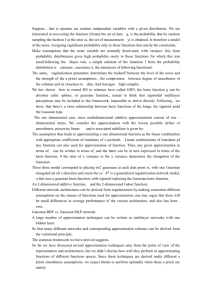
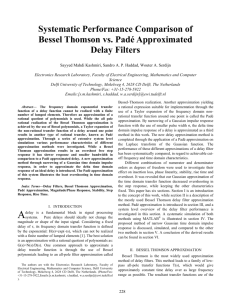
![1 = 0 in the interval [0, 1]](http://s3.studylib.net/store/data/007456042_1-4f61deeb1eb2835844ffc897b5e33f94-300x300.png)
